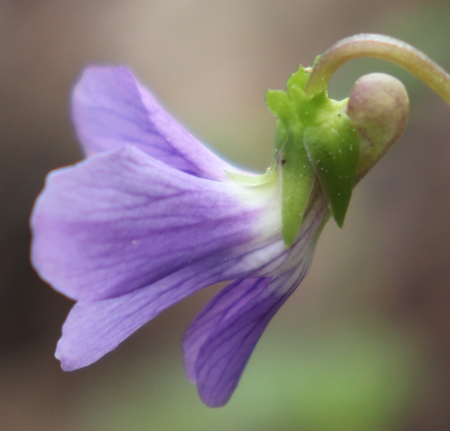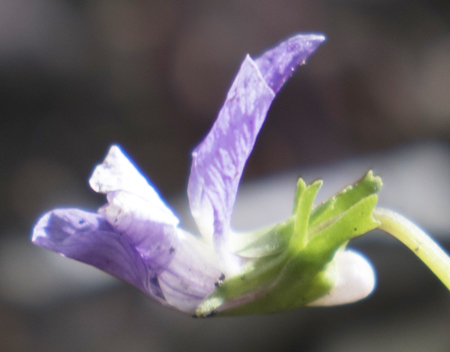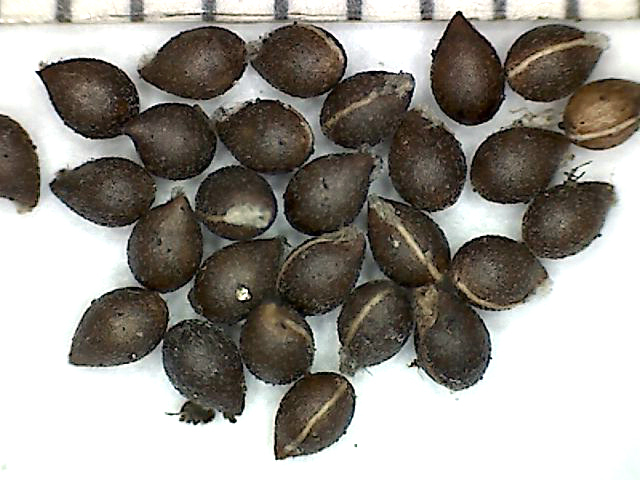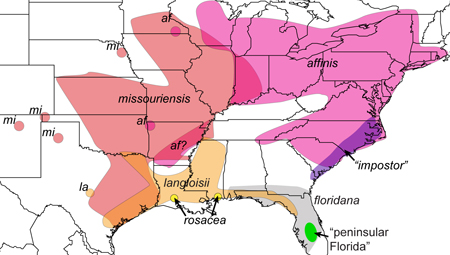Viola impostor R.N.Burwell & H.E.Ballard, ined.
Common names:
Impostor Violet
Synonyms:
None.
Description:
Acaulescent rosulate perennials from thick rhizome, ≤ 16 cm tall; foliage light to medium green with petioles, peduncles and calyx green or more commonly purple-tinged or -spotted, glabrous; stipules free, irregularly glandular-fimbriate; leaves ascending, undivided, largest ≤ 68 × 57 mm, distinctly longer than broad and narrowly ovate in chasmogamous flower, base cordate, apex acute to acuminate, margins crenate-serrate, eciliate, teeth shallower and more remote near the tip, broadening in fruit to approx. as broad as long, deltate-triangular to deltate-reniform, apex acute to obtuse; chasmogamous peduncle held above the leaves; chasmogamous flower ≤ 13 mm long; calyx glabrous, eciliate; lowest sepals lance- to ovate-triangular, acuminate from base to a narrowly and sharply acute apex; auricles slender and prominent to long-quadrate, erose, elongating to 3–5 mm in fruit; corolla pale violet with weak darker flush on lateral petals near throat, throat white; spur short-globose; lateral petals densely bearded with slightly clavate hairs, spurred petal glabrous; chasmogamous capule green; cleistogamous flowers produced after chasmogamous, the declined to ascending peduncle shorter than or occasionally equaling petioles; cleistogamous capsule 9–12 mm with fine purple spots or blotches at least at base of capsule, glabrous; seeds 1.3–1.8 × 0.9–1.2 mm, dark brown, unspotted, with sharply contrasting white raphe.
Similar species:
This species is most similar to several other homophyllous undivided glabrous species with leaves longer than broad in chasmogamous flower but broadening significantly in fruit. It differs in chasmogamous flower from Viola affinis and V. retusa in its glabrous spurred petal and prominent to elongate auricles; from V. cucullata by the even more elongate auricles, longer lateral petal beards, and lack of dense strongly contrasting eyespot around the throat; and from V. langloisii, V. missouriensis and V. retusa in the prominent to elongate slender auricles. In cleistogamous fruit it differs from all the above species in the finely spotted cleistogamous capsule on short declined peduncle, conspicuously elongate auricles, and unspotted dark brown seeds with a white raphe.
Ecology:
Sandy alluvium along streams and rivers, usually near the coast.
Distribution:
Se. Lower Atlantic Coastal Plain, se. VA south to GA.
Rarity:
None.
Phenology:
Chasmogamous flower March–April, chasmogamous fruit April–May, cleistogamous fruit May–October.
Affinities:
This species belongs to the Acaulescent Blue Violet lineage, sect. Nosphinium W.Becker, subsect. Boreali-Americanae (W.Becker) Gil-ad, in the Affinis species group.
Hybrids:
I have collected hybrids with V. edulis at Elwell Ferry, North Carolina. The plants had mostly intermediate foliage characteristics. No information on hybrid reproduction is available.
Comments:
We first detected this undescribed species in March 2018, where we found populations near and in swamps bordering riverbanks within 30 miles of the coast from Georgia to North Carolina. Its distinctive well elevated chasmogamous flowers, far overtopping the small undivided leaves, and the unusually elongate erose auricles made it easy to spot. We quickly confirmed it as an overlooked regional endemic on the southeastern Atlantic Coastal Plain and have reidentified several herbarium specimens (all previously named V. cucullata) to fill out the range, including one specimen from extreme southeastern Virginia. While the present species shares certain features with V. cucullata and others with V. edulis, it differs from those in the commonly purple-spotted or -tinged petioles, peduncles and calyx, short declined to ascending cleistogamous peduncle, finely purple-spotted cleistogamous capsule, and dark brown seeds with sharply contrasting white raphe. This and other members of the Affinis species group are currently under study by Remington Burwell at Ohio University.
Literature Cited:
None.

Chasmogamous flowering habit by Bina Sitepu

Cleistogamous fruiting habit by Harvey Ballard

Leaves during post-chasmogamous flower by Harvey Ballard

Chasmogamous flower front view by Bina Sitepu

Chasmogamous flower profile view showing short auricles and broad sepals by Bina Sitepu

Chasmogamous flower profile view showing long auricles and narrow sepals by Bina Sitepu

Cleistogamous fruit by Harvey Ballard

Seeds from herbarium specimen: Transplanted from SC, Horry Co., Bucks Landing, 31 Mar 2018, H. Ballard 18-001A, A. Stuart, J. Hastings, B. Sitepu (BHO)

Map of the Affinis species group by Harvey Ballard